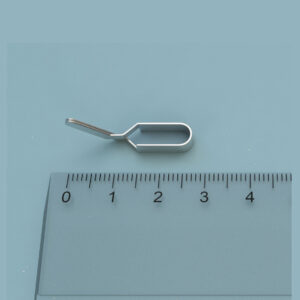$4,990.00
The MazeEngineers tap-elicited swim test assesses the impact of ethanol (EtOH), various drugs, and toxins on the non-associative learning of free-swimming zebrafish. Commonly observed behaviors include the “C-start” response, which shows increased latency following early alcohol exposure. The MazeEngineers Tap Swim apparatus features eight user-friendly arrays that attach to an automated tap array positioned below. This setup is managed by the Conductor software, provided at no cost, which controls the interval and timing of the taps.

MazeEngineers empowers preclinical neuroscience research with meticulously designed, customizable behavioral apparatuses. From manual classic mazes to fully automated smart systems, we provide the tools scientists need to capture high-quality, reproducible data for studies on learning, memory, anxiety, and depression.




Take advantage of Neuralynx, Ethovision Integration, SMS and Email integration with the Conductor Science Software. No I/O Boxes Required
Features |
Number of Arenas: 2×4 array |
Individual Arena: 6cm diameter; 9cm height |
Separators (12cm height) |
Tap controlled by Conductor; 8 independent controls |
Key variables that can be controlled include:
Integration with Conductor allows for access to Noldus Ethovision control of taps with the Noldus Baton. Set taps depending on zebrafish behavior.

The tap-elicited startle response in zebrafish serves as a reliable and adaptable neurobehavioral assessment tool for toxicological and pharmacological research (Eddins et al., 2010). This test evaluates the effects on swimming activity related to muscle function and diseases (Lebold et al., 2013; Sztal et al., 2016) and changes in short-term memory (Levin and Cerutti, 2009).
The apparatus generally comprises a 2×4 array of chambers separated by opaque barriers to prevent visual interaction between tanks. This setup allows for the simultaneous testing of eight fish, with each fish in a separate tank. An automated solenoid beneath the tanks is recommended to produce the taps, and an additional automated system is used to control the number and timing of taps between trial blocks. A video camera connected to tracking software can record the swimming behavior.
The experimental protocol begins with an acclimatization period in the test room and chambers. Following this, baseline responses and habituation to closely spaced or multiple taps are assessed. Test trials are conducted at predetermined time points, depending on the study’s objectives. Both single and multiple tap responses can be examined.
Using zebrafish enables high-throughput studies of neurodevelopmental defects caused by toxicant exposure, such as alcohol (Carvan et al., 2004), or neurological diseases, along with drug screening. Compared to mammals commonly used in research, zebrafish offer advantages such as ease of reproduction in large numbers, rapid development, and low experimental costs. Additionally, their vertebrate status allows for better extrapolation of findings.
We recommend testing fish individually within a setup consisting of a 2×4 array of cylindrical chambers or tanks. The dimensions can vary: for instance, Sztal et al. (2016) used tanks with a 50-mm diameter, while Eddins et al. (2010) employed tanks with a 60-mm diameter and a height of 90 mm, filled to a depth of 20 mm. The tank water should be made from deionized water mixed with sea salts. To prevent visual contact between fish, opaque-white dividers should be used (Eddins et al., 2010). An automated solenoid should be installed beneath the tanks to generate the taps, and an additional automated system is necessary to control the number and timing of taps between trial blocks. Swimming behavior should be recorded using a video camera centrally positioned above the array, connected to tracking software for optimal data analysis. The placement of dividers should not obstruct the camera’s view to ensure successful video recording.
Testing
Groups of up to eight fish can be tested simultaneously, with one fish in each chamber. The software used should be capable of recording rapid swimming activity; for instance, Eddins et al. (2010) recorded fish positions at a rate of six times per second. Acceleration peaks typically occur immediately following taps (Sztal et al., 2016). In studies analyzing the developmental impact of toxic agents or drugs, Eddins et al. (2010) evaluated startle responses across 10 trials with 1-minute intertrial intervals to establish baseline response and habituation through repeated testing. Further trials at 8, 32, and 128 minutes measured the reestablishment of the startle response without closely spaced trials.
In contrast, Lebold et al. (2013) studied the long-term effects of nutritional deficiencies by conducting three initial trials of 6 minutes without stimuli to evaluate baseline swimming behavior. The results from each fish were averaged. This was followed by two additional trials: the first with a single tap stimulus and the second with multiple taps (one tap every 5 seconds for a total of 18 taps over 90 seconds). Swimming speeds and distances were recorded, with a 1-hour rest period between the single and multiple tap trials.
Different inter-block intervals can be employed within the same study. To assess short-term memory, Levin and Cerutti (2009) varied the stimulus rates, delivering 20 taps with a 10-second inter-block interval, immediately followed by another 20 taps with a 20-second inter-block interval.
In addition to measuring startle response through the distance swam, touch-evoked tests can be utilized to evaluate swimming kinematics. This includes analyzing the shape and speed of the body wave during swimming motion (Muller and van Leeuwen, 2004) to provide a quantitative assessment of locomotor behavior.
Data analysis for the tap-elicited swim test generally involves comparing the distances swam by the zebrafish (Eddins et al., 2010). The results can be presented in several ways: variations across trials (A), distances swam during or after specific trials (B), or the average distance swam within the same block of trials (C). While distances are often measured in cm/5 sec (Eddins et al., 2010), the total distance swam per minute following a tap can also be utilized (Lebold et al., 2013). The results are typically reported as mean ± standard error of the mean (SEM).
The tap-elicited swim test facilitates toxicological and pharmacological research, including developmental assessments and evaluations of muscle function and short-term memory (Levin and Cerutti, 2009; Sztal et al., 2016). It also allows for comparisons of different genetic backgrounds and the effects of genetic manipulations.
Using zebrafish in these studies offers several advantages: their optical clarity aids in studying neurodevelopmental processes, and as vertebrates, they provide better extrapolation to higher organisms. This model boosts experimental throughput while reducing costs compared to mammalian models, as zebrafish breed easily in large numbers and require minimal housing space. Additionally, their development is rapid; spontaneous muscle contractions occur within 24 hours post-fertilization, and controlled swimming behaviors are observed by 48 hours post-fertilization (Sztal et al., 2016).
When studying the effects of drugs in zebrafish through immersion, it is important to be cautious due to potential issues with water solubility and pharmacokinetics, which can affect translational validity (Bailey et al., 2015).
Moreover, in studies investigating memory alterations, neurobehavioral assessments in zebrafish do not allow for detailed analysis of specific central nervous system regions. However, the brain structures in zebrafish are biochemically and functionally similar enough to those in mammals to support neuropharmacological studies (Bailey et al., 2015). Careful attention must be given to the experimental design to ensure that observed differences are due to changes in cognition rather than motor effects (Bailey et al., 2015).
Yes, please let us know and we can customize an array for you
Yes, please let us know. We need to ensure that the tap provides a consistent force, however, if you have a modification within 25% of the original sizing the tap force will be constant
There are no questions yet. Be the first to ask a question about this product.